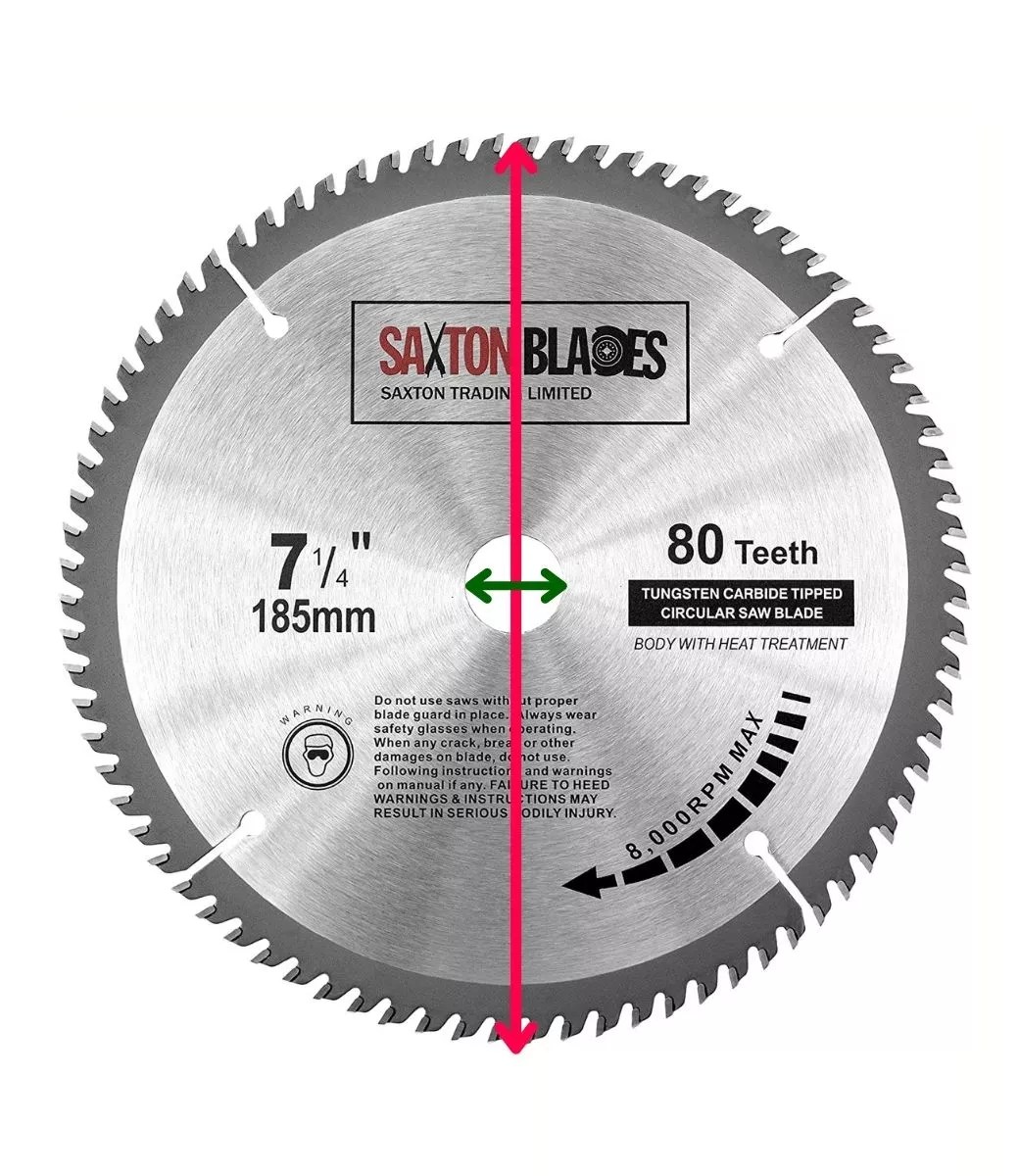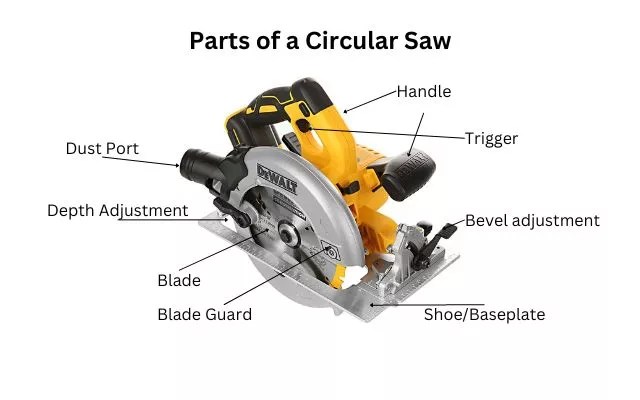A circular saw is a really versatile power tool that can be used for a variety of woodworking projects, from cutting plywood, cutting floorboards, cutting decking boards, and general purpose sawing. It is a must-have tool for any beginner who wants to own a power saw.
Our guide will take you through the key factors that you need to consider when choosing a circular saw and how to use it safely and effectively. Here at UK Tool Guide, we like to keep our guides informative, helpful and easy to understand.
Types of Circular Saws
There are two main types of circular saws:
- A sidewinder – These are the most common type of circular saw. They are generally lighter and less expensive than worm drive saws. Sidewinder saws are a good choice for most woodworking projects.
- A worm drive – Worm drive saws are more powerful and durable than sidewinder saws. They are a good choice for heavy-duty use, such as framing timber or cutting thick materials. However, worm drive saws are also heavier and more expensive than sidewinder saws.
Most Important Features to Consider
- Power Options
- Blade Size
- Cutting depth
- Bevel Capacity
1. Power Options
Circular saws are powered by either normal electricity (corded) or by batteries. Cordless
- Corded saws offer more power and are typically less expensive than cordless saws. They have the disadvantage of a trailing lead. You also need to have an available UK main’s socket. On average these cost between £50-£80 in the UK.
- Cordless saws are more portable and convenient to use. If you are new to cordless saws, then you need to buy the saw, a compatible battery and a charger. To get the most benefit from the saw a 4.oAh battery or larger is recommended. It is also recommended to have 2 batteries, so as you can be using one, and have another one charging. On average these cost between £100-£500 in the UK.
2. Blade Size
Circular saws come in a variety of blade sizes, ranging from 165mm to 216mm. The blade size you choose will depend on the types of projects you plan to use the saw for. If you’re a beginner, it’s a good idea to start with a 184mm saw, as this is the most common size and offers the widest variety of blades.
You can also get blades for cutting through wood, thin metal and masonry. With reference to wood, you can buy blades with various tooth sizes (TPI) for making coarse cuts or fine cuts. The more TPI, the finer and neater the cut will be. TPI stands for “Teeth per Inch.”
3. Cutting Depth
This is an important feature to give a lot of consideration to. The cutting depth of a circular saw is determined by the size of the blade. A 184mm saw can typically cut through 55mm timber in a single pass.
This is calculated by taking the diameter of the blade, subtracting the bore size and dividing by 2.
The better quality circular saws will also allow you to set the depth.

4. Bevel Capacity
The bevel capacity of a circular saw refers to the angle at which the blade can be tilted. A typical circular saw has a bevel capacity of 45 degrees, which allows you to make angled cuts.
Circular saws can make various types of cuts, including bevel cuts, where the blade is tilted to create an angled edge on the material being cut. The bevel capacity specification is important for users who need to make bevel cuts for applications such as creating angled edges, mitre joints, or beveled edges in woodworking and other construction projects.
For example, if a circular saw has a bevel capacity of 45 degrees, it means that the saw blade can be tilted up to 45 degrees from the vertical position. This allows the saw to make bevel cuts at angles ranging from 0 degrees (straight cut) to 45 degrees.

Other Features to Consider
- Laser Guide
- Spindle lock
- Electric brake
- Dust extraction port
1. Laser line
A laser guide helps you to keep the saw aligned and straight as you cut. A small laser is mounted on the saw that projects a visible line onto the material you’re cutting. This line corresponds to the path that the saw blade will follow, allowing you to see exactly where the cut will be made before you start.
As a beginner it can be handy for any jobs that require precision. Just be aware that not all circular saws come with a laser guide, and some users may prefer traditional methods like using a pencil and a straight edge to mark their cutting lines.
2. Spindle lock
A spindle lock makes it easy to change blades. It stops the rotation of the saw’s arbor or spindle, which is the shaft on which the saw blade is mounted. Once you activate the spindle lock, it will keep the spindle stationary, making it easier to loosen and tighten the bolt that secures the saw blade.
3. Electric brake
An electric brake stops the blade quickly when you release the trigger. This is a great safety feature. It quickly stops the rotation of the saw blade when you release the trigger or switch that controls the saw’s power. In contrast saws without electric brakes, the blade may continue to spin for several seconds after you release the trigger.
4. Dust extraction port
A dust extraction port allows you to attach a vacuum cleaner to the saw to collect sawdust and debris. Circular saws create a significant amount of dust as they cut through materials, and the dust extraction port helps to keep the work area cleaner.
Choosing the Right Circular Saw for Your Needs
If you’re a beginner, I recommend choosing a sidewinder circular saw with a 184mm blade. This type of saw is versatile and easy to use, and it’s a good choice for most woodworking projects. I would also recommend buying a cordless version with 2 batteries and a charger. Make sure to buy from a reliable quality brand with good UK customer service.
If you need a more powerful saw for heavy-duty use, consider a worm drive circular saw. However, keep in mind that worm drive saws are heavier and more expensive than sidewinder saws. Beginners will really not need this particular type as they are used in larger industries.
Using a Circular Saw Safely
When using a circular saw, it’s important to follow safety precautions to avoid injury. Here are a few tips:
- Always wear safety glasses or googles and ear protection.
- Make sure the saw is unplugged or the battery is removed before changing blades.
- Use a sharp blade for cleaner cuts and to reduce the risk of kickback. These do need to be changed regularly
- Clamp the workpiece in place before cutting.
- Hold the saw firmly with both hands and keep your fingers away from the blade.
- Keep an eye on the saw’s cord or battery pack and make sure it doesn’t get in the way of the blade.
- Make sure the saw is properly lined up before you start cutting.
- Use a push stick to feed the workpiece through the saw.
- Never cut across the grain of the wood.
- Be careful when cutting curves or circles.
- Clean the saw regularly to keep it in good condition.
Buying Tips & Help
- Consider your budget. Circular saws in the UK can range in price from around £50 to £500. If you’re a beginner, you don’t need to spend a lot of money on a saw. A basic sidewinder saw with a 184mm blade will be sufficient for most projects.
- Read reviews of different circular saws before you buy one. This will help you to get an idea of the pros and cons of each saw.
- If possible, try to use the saw before you buy it. This will give you a chance to see how it feels and handles.
- Be sure to use the right blade for the job. There are different types of circular saw blades available, each designed for a specific purpose. For example, there are blades for cutting wood, metal, and masonry.
A circular saw is a valuable tool for any beginner. By following the tips in this guide, you can choose the right saw for your needs and use it safely and effectively.